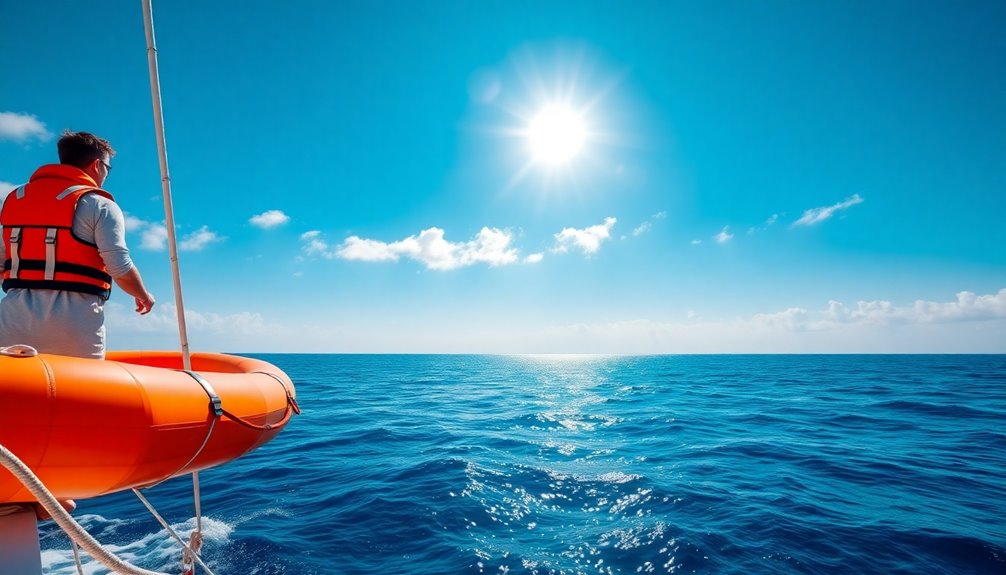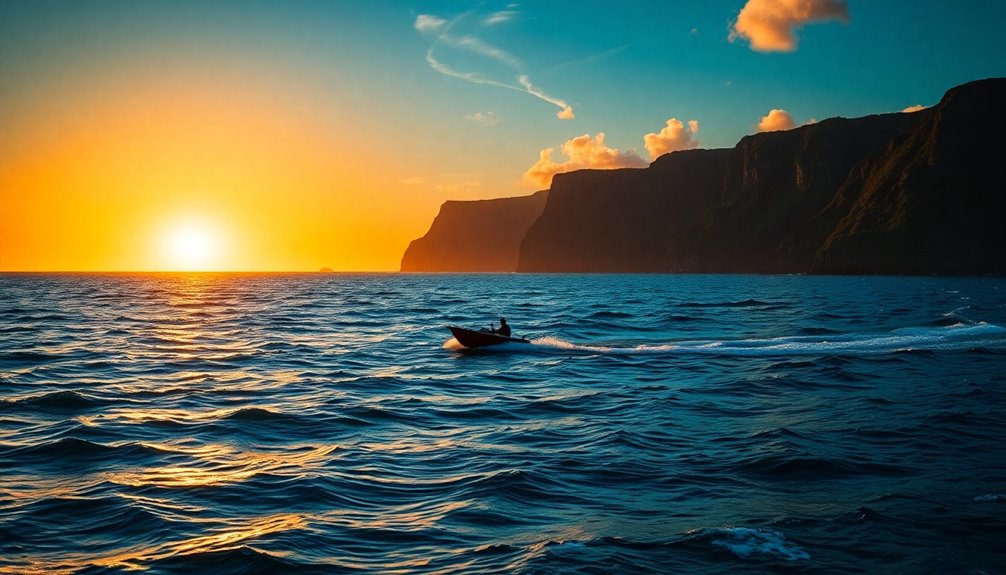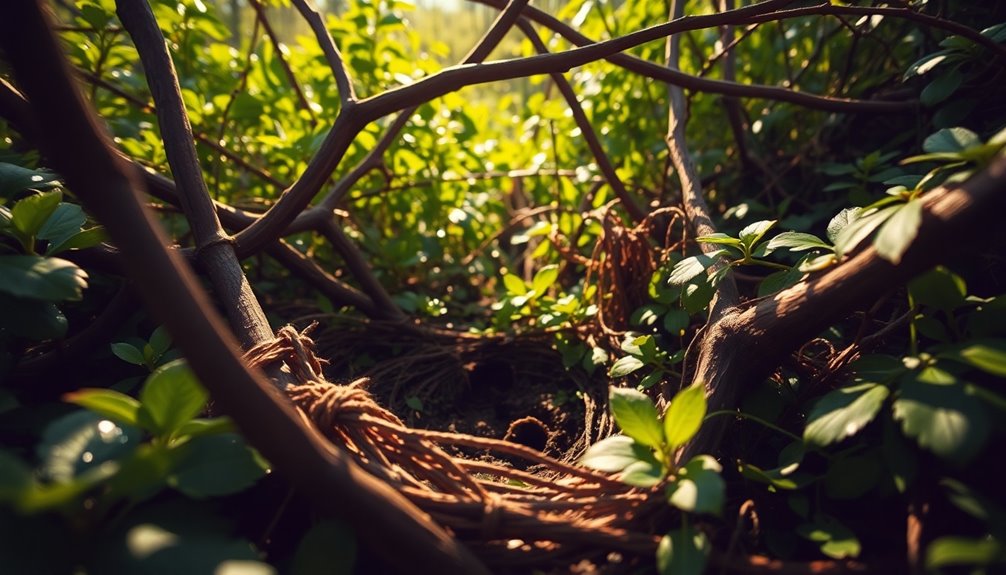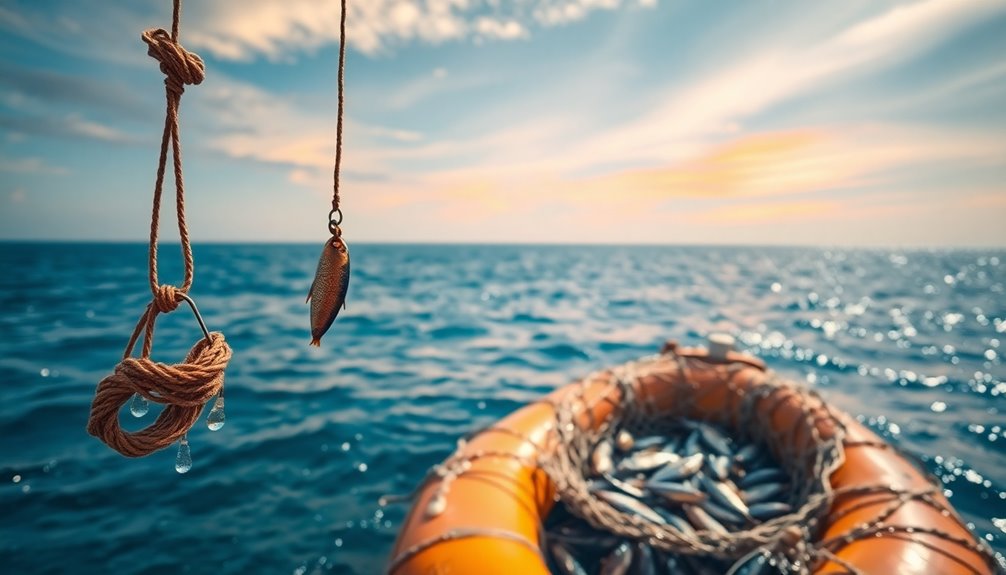Staying afloat at sea means mastering techniques to ensure your safety and that of your vessel. First, always wear a well-fitted life jacket and have emergency supplies ready. Knowing how to float effectively is key; lie on your back, spread your arms and legs, and focus on your breathing. In rough seas, adopt a vertical position to avoid inhaling water. Use flares or VHF radios for emergency signaling, and stay calm to enhance your chances of survival. Being prepared is crucial, and there's much more to explore about enhancing your safety on the water.
Key Takeaways
- Utilize the "Float to Live" technique by lying on your back with arms and legs spread to maximize buoyancy and conserve energy.
- Regularly inspect and maintain safety equipment, including life jackets and communication devices, to ensure they are functional and ready for emergencies.
- Use high-visibility signaling devices like flares, whistles, and reflective mirrors to attract attention and communicate your location during distress.
- Stay calm and mentally prepared; familiarize yourself with survival techniques and practice them to enhance your chances of survival in emergencies.
- Ensure proper ventilation and maintain air quality on your vessel to enhance comfort and safety during your journey at sea.
Introduction
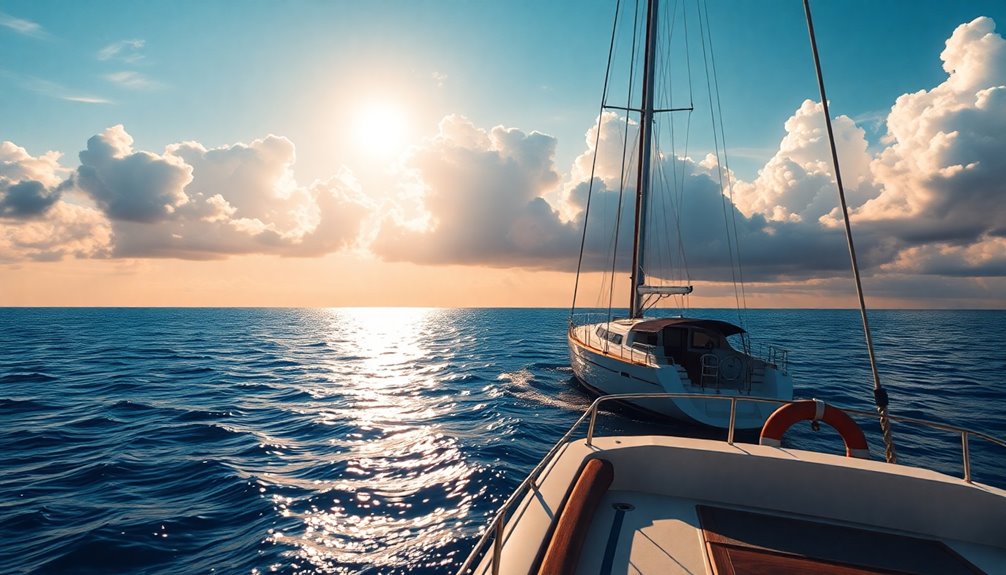
When you're out at sea, knowing how to stay afloat is essential for your safety.
This article will explain key floating techniques and survival strategies that can help you navigate emergencies effectively.
Key Floating Techniques Explained
Safety at sea relies heavily on mastering key floating techniques that can mean the difference between life and death.
The essential floating technique involves lying on your back with your arms and legs spread to maximize surface area and maintain buoyancy. Relaxation is crucial; staying calm and focusing on your breathing helps stabilize your position in the water.
In rough seas, adopt a vertical position to avoid inhaling water, while in calm conditions, keep a horizontal position with your knees slightly raised. Utilize any trapped air in your clothing to enhance buoyancy, so minimize movement to preserve this air.
Remember the "Float to Live" method, which emphasizes floating to conserve energy and maintain body heat while waiting for help or swimming to safety.
Survival Techniques for Sailors
Survival techniques for sailors can make all the difference in an emergency situation at sea. Proper preparation is vital; always wear your life jacket and have emergency supplies ready.
Staying calm and composed during crises enhances your chances of survival. Familiarize yourself with essential survival techniques, such as floating and utilizing available resources, to manage unexpected water incidents effectively.
Regularly maintain your vessel and safety gear to prevent accidents and ensure you're always ready for emergencies. Engaging in sea survival training courses will equip you with the critical skills and knowledge needed to tackle various maritime challenges.
Key Concepts of Buoyancy
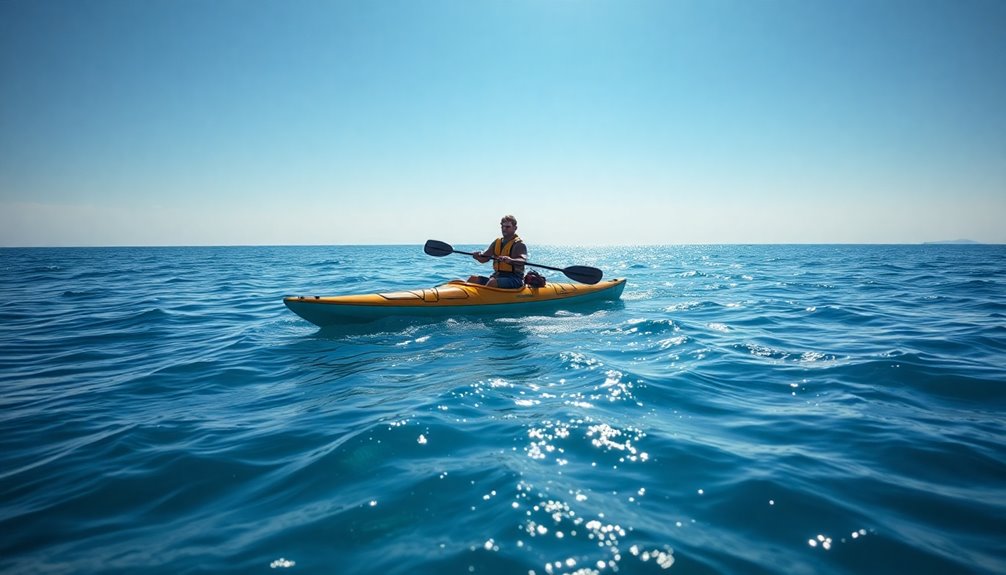
Buoyancy plays a crucial role in keeping you safe at sea, as it's the upward force from water that allows objects to float.
Essentially, buoyancy occurs when an object's weight is less than the weight of the displaced fluid. To maintain buoyancy, spread your arms and legs to increase surface area, enhancing your stability and reducing the risk of sinking.
Remember, relaxation is key; tension can lead to submersion, so focus on slow, deep breathing.
Wearing a well-fitted life jacket significantly boosts buoyancy, keeping your head above water. Additionally, the trapped air in your clothing can aid buoyancy when you're overboard, as many garments retain air to assist in floating.
Understanding these concepts is vital for your safety.
Life-Saving Buoyancy Techniques
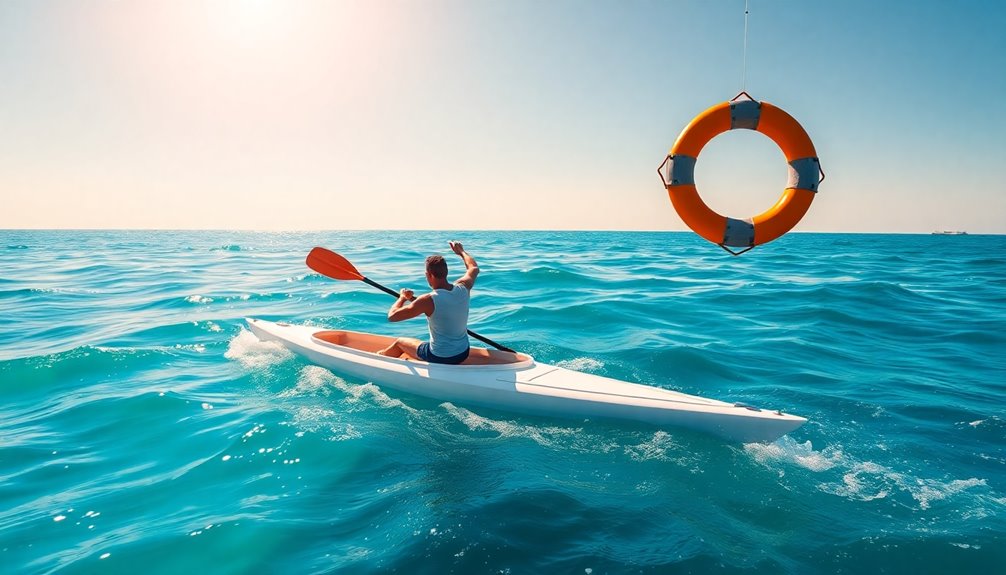
In emergencies, your survival often hinges on your ability to stay afloat.
Weather conditions can dramatically impact your chances, so understanding buoyancy techniques is essential.
Survival Rates in Emergencies
Many people underestimate the importance of staying calm during a water emergency, yet it's one of the most crucial factors in improving your chances of survival. Panic can lead to rapid exhaustion and submersion, drastically lowering your survival rates.
Instead, float on your back with your arms and legs spread; this increases your surface area and enhances buoyancy, allowing you to conserve energy while waiting for rescue. In cold water, floating helps counteract cold water shock, which can be life-threatening.
Additionally, wear appropriate clothing to trap air and ensure your life jacket fits properly to boost buoyancy.
Finally, grab any floating objects, like pool noodles or debris, to provide essential support and prevent drowning, enhancing your overall survival prospects.
Weather Conditions Impact Survival
How well do you understand the weather conditions before heading out to sea? Knowing the forecast is crucial for your safety and survival at sea.
Adverse weather can increase the risk of capsizing or falling overboard, making buoyancy techniques essential. In rough seas, adopt a vertical position to help you stay afloat and avoid inhaling water.
Be cautious of cold water shock, especially in temperatures below 15°C—floating conserves energy and helps maintain body heat. Spread your arms and legs to increase surface area, which aids buoyancy in turbulent waters.
Regularly monitor weather updates to prepare for sudden changes that could affect your survival strategies.
Effective Buoyancy Exercises
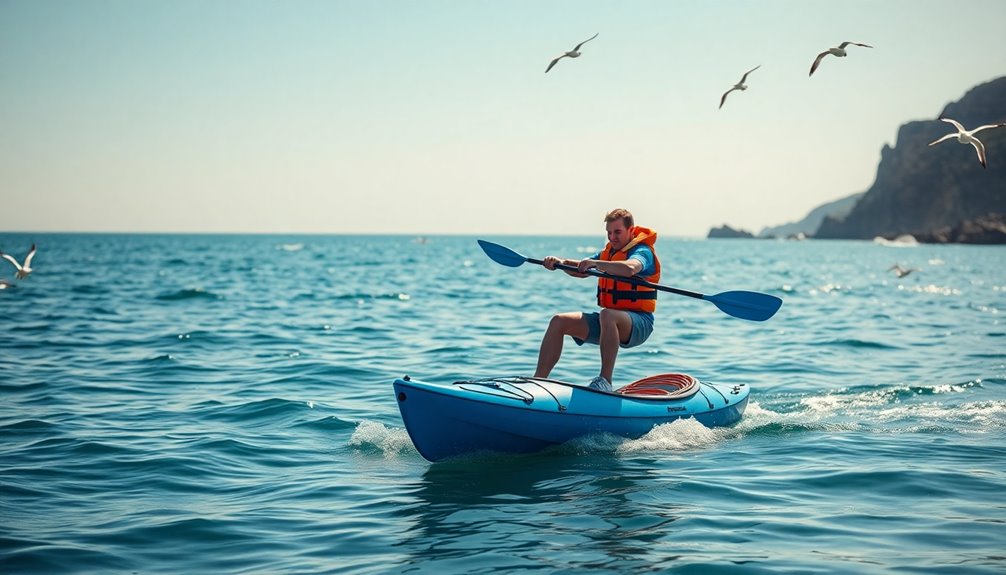
Mastering buoyancy exercises can significantly enhance your confidence and safety in the water. Start by practicing in a controlled environment, like a swimming pool, where you can familiarize yourself with floating techniques.
One effective buoyancy exercise is to lie back in the water with your arms and legs spread wide. This position increases your surface area, helping you stay afloat. Focus on gradual deep breathing—slow, controlled inhalations and exhalations—to promote relaxation and improve your buoyancy.
You can also incorporate floating aids, such as pool noodles or kickboards, to build your confidence and illustrate buoyancy principles.
Regularly practicing these buoyancy exercises instills muscle memory, reduces panic, and boosts your chances of surviving unexpected water incidents.
Essential Safety Equipment Checklist
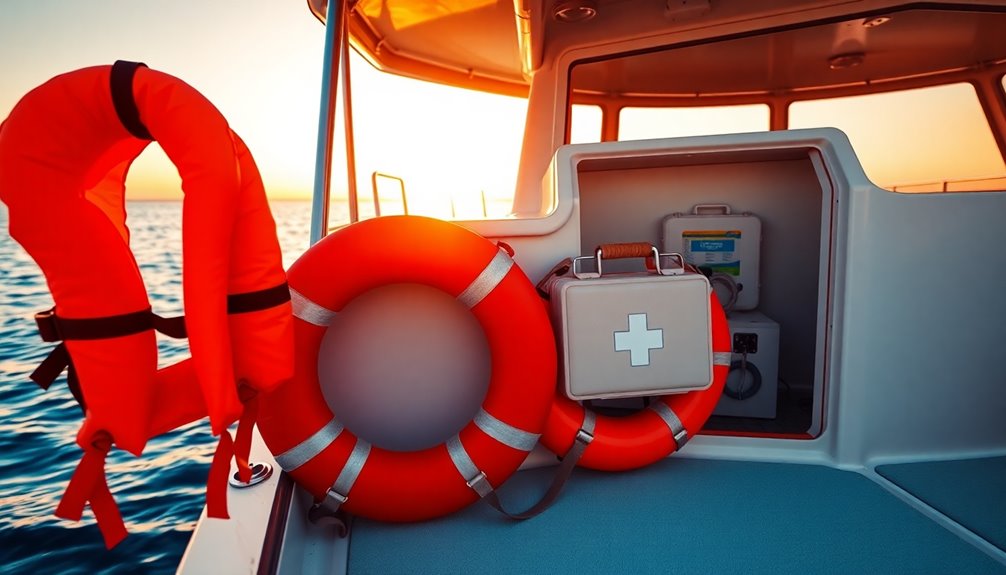
Before you set sail, having the right safety equipment on board is crucial for ensuring a secure experience at sea.
First and foremost, make sure every passenger has a properly fitting life jacket, as these are essential for buoyancy in emergencies.
Additionally, always carry flares and a VHF radio to communicate and signal for help if needed.
Your vessel should also be equipped with a well-stocked first aid kit to address injuries until professional help arrives.
Don't forget about visibility; appropriate boat lighting is vital, especially in low visibility conditions, to prevent accidents.
Finally, regularly inspect all safety gear to ensure functionality and compliance with maritime regulations, so you're prepared for any emergency that may arise.
Emergency Signaling Techniques
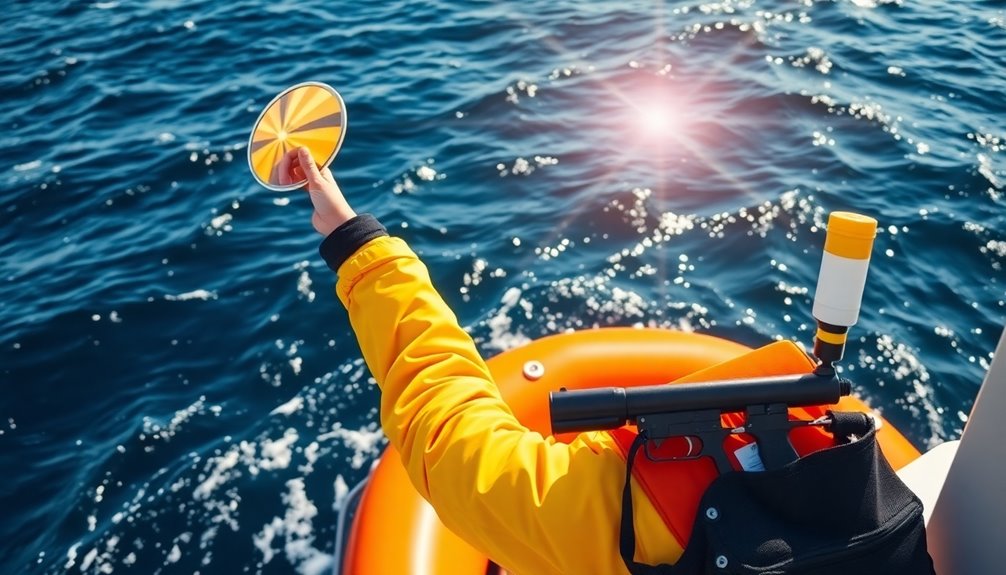
With the right safety equipment on board, knowing how to signal for help in an emergency is just as important.
To stay safe, use flares as they're high-visibility devices that can be seen from miles away, alerting nearby vessels or rescue teams. A VHF radio is essential; it lets you quickly contact the coastguard or other boats.
Don't underestimate the power of a whistle—its sound carries well over water and doesn't require batteries. For daytime emergencies, use a mirror to reflect sunlight or a flashlight at night to send SOS signals.
Lastly, colorful flags or bright cloths can create visual signals to indicate your location and need for assistance.
Master these emergency signaling techniques to enhance your safety at sea.
Overcoming Panic in Emergencies
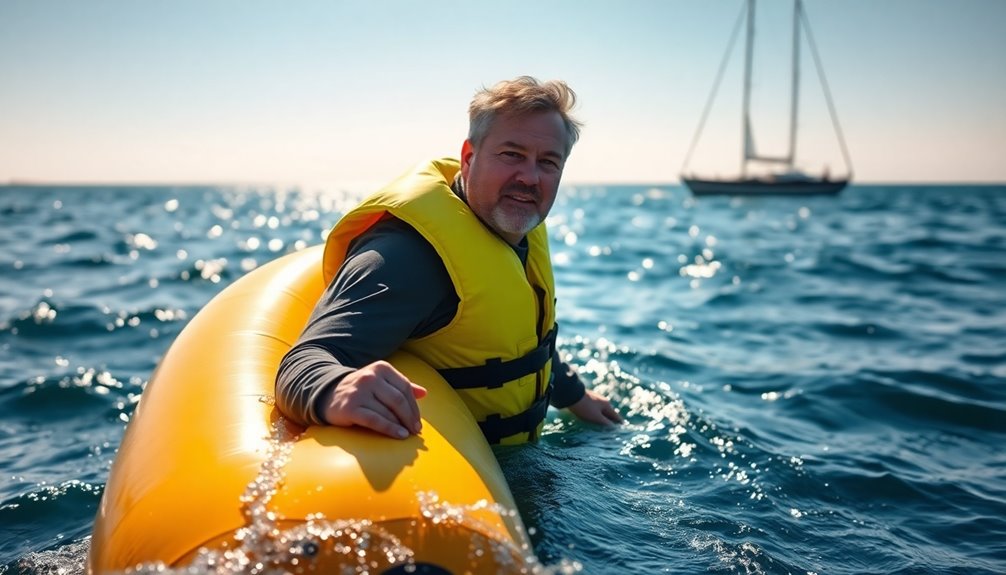
When you're faced with an emergency at sea, your survival can hinge on how well you manage panic.
Understanding how water temperature affects survival rates and maintaining your safety gear can help you stay calm and focused.
Survival Rate by Water Temperature
Survival in cold water hinges on your ability to remain calm and focused.
When you find yourself in frigid temperatures below 15°C, the risk of cold water shock skyrockets. Panic can quickly set in, causing you to lose breath control and experience a rapid heart rate, both of which hinder your chances of survival.
Instead of succumbing to fear, concentrate on floating techniques. Staying horizontal while floating helps conserve energy and body heat, crucial for survival.
Remember, you could become incapacitated in just a few minutes due to cold water shock, so immediate action is vital.
Safety Gear Maintenance Tips
Safety gear is your lifeline in emergencies, and keeping it in top shape is crucial. Regularly inspect all safety equipment, like life jackets and flares, to ensure they're functional and free from wear.
Check communication devices, such as VHF radios, to confirm they're operational and fully charged before you set sail. Maintaining a well-stocked first aid kit is essential; don't forget to check expiration dates on supplies periodically.
After each use, clean and store safety gear properly to prevent deterioration. Finally, familiarize all passengers with the location and proper use of safety gear. Additionally, ensure that air quality is optimized on your vessel by regularly maintaining air purifiers to help reduce allergens and improve comfort.
These safety tips help everyone stay calm and act quickly during emergencies, significantly reducing panic when it matters most.
Survivor Stories From the Ocean
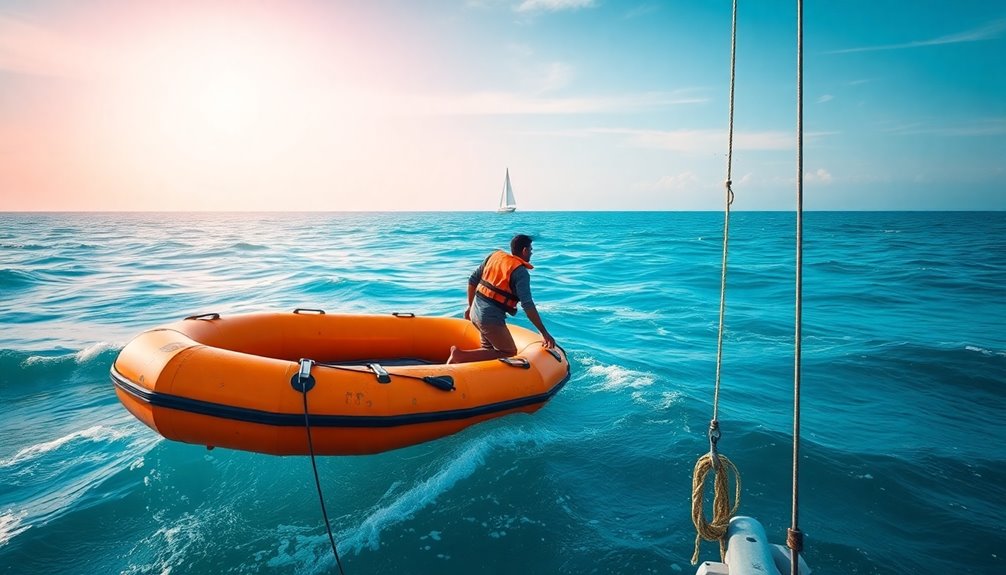
Amid the vastness of the ocean, survivor stories reveal powerful lessons in resilience and resourcefulness. Tina's experience stands out; by staying calm and using the "Float to Live" technique, she managed to stay afloat in the water until help arrived.
Many survivors emphasize that knowing how to float and employing relaxation strategies can significantly prolong survival in challenging ocean conditions. The Float to Live campaign shares these inspiring accounts to raise awareness about floating and water safety education.
Personal testimonials often highlight the essential role of mental preparedness and staying with your vessel, as it greatly enhances your chances of rescue. These stories remind you that knowledge and composure can be lifesaving in dire situations.
Conclusion
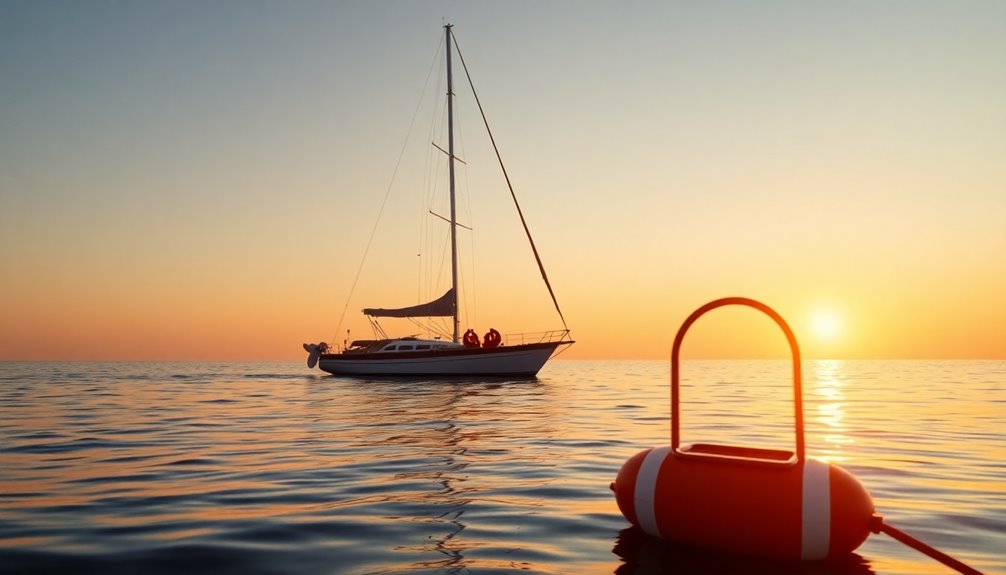
While the ocean can be unpredictable and sometimes perilous, understanding and mastering essential techniques can significantly enhance your safety at sea.
To stay safe, you need to master floating techniques, like lying back with arms and legs spread, which help conserve energy and maintain buoyancy. Always wear a properly fitting life jacket, as it enhances safety and reduces drowning risks.
Stay aware of environmental conditions, such as rip currents and cold water shock, to make informed decisions. Regularly inspect and maintain your safety gear and vessel to prevent accidents.
Lastly, engaging in sea survival training equips you with vital skills and knowledge, ensuring you're prepared to respond effectively to emergencies.
Additional Resources
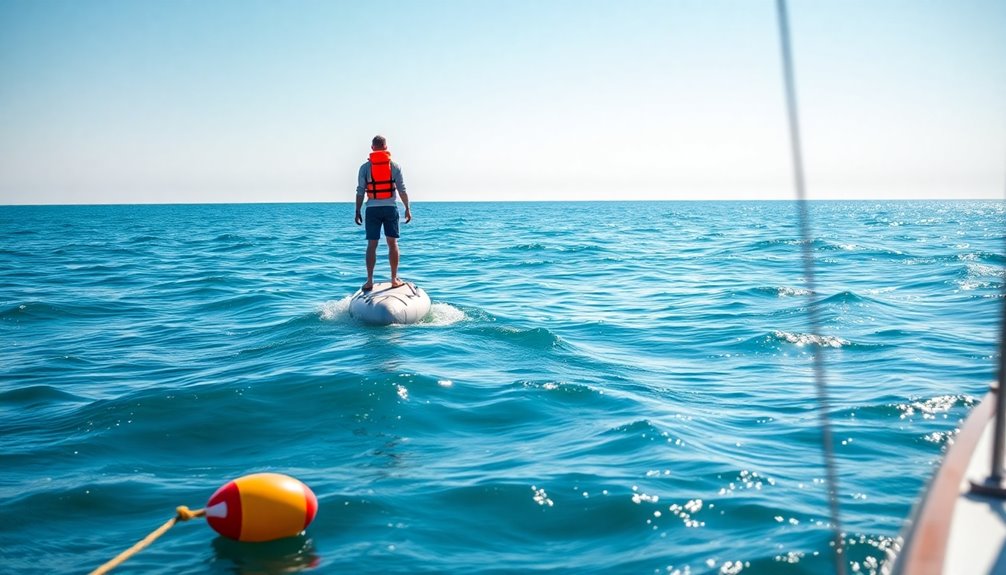
To further bolster your knowledge and preparedness for life at sea, a variety of valuable resources are available.
The Float to Live campaign offers downloadable materials that teach essential floating techniques crucial for survival in water emergencies. Personal survival stories, like Tina's, reveal how staying calm can make a difference.
The RNLI provides guidance on local conditions and rip currents, helping you stay aware and safe at the coast. Don't forget the importance of emergency contact information; in the UK, you can call 999, and in Ireland, 112, to access coastguard assistance when you need to call for help.
Additionally, consider enrolling in online courses to enhance your boating skills focusing on safety and emergency preparedness.
Frequently Asked Questions
What Are the Three Principles of Survival at Sea?
The three principles of survival at sea are essential for your safety.
First, you need to stay afloat, which helps keep you visible and reduces exhaustion.
Next, signaling for help is vital; use flares or bright objects to attract attention.
Lastly, conserving energy is crucial. By minimizing movement and staying calm, you maintain body heat and mental clarity, increasing your chances of survival until rescue arrives.
Remember these principles in any maritime emergency!
How Do You Stay Safe When Swimming in the Sea?
When you swim in the sea, always choose areas with lifeguards on duty.
Familiarize yourself with local conditions and pay attention to any warnings about currents or tides.
If you find yourself struggling, use the floating technique by lying on your back, spreading your arms and legs.
Stay calm, breathe steadily, and keep an eye on your surroundings.
Having a plan for returning to shore can help you stay safe if conditions change.
How Long Can You Stay Afloat at Sea?
You can stay afloat at sea for varying lengths of time, depending on factors like water temperature, your physical condition, and clothing.
In cold water, hypothermia can set in quickly, reducing survival time. Staying calm and using effective floating techniques helps conserve energy and maintain buoyancy.
While you can survive without food for days, access to fresh water is crucial, as dehydration will impact your ability to stay afloat longer.
How to Survive Being Stranded in the Middle of the Ocean?
If you find yourself stranded in the middle of the ocean, stay calm to think clearly.
Use any floating objects around you to conserve energy and maintain buoyancy.
Keep your body warm and dry to fight off hypothermia.
Signal for help with flares or a radio if you have them.
Prioritize drinking water; rainwater collection can be lifesaving.

